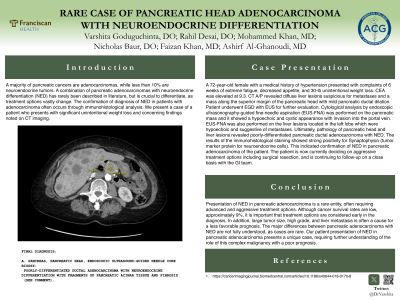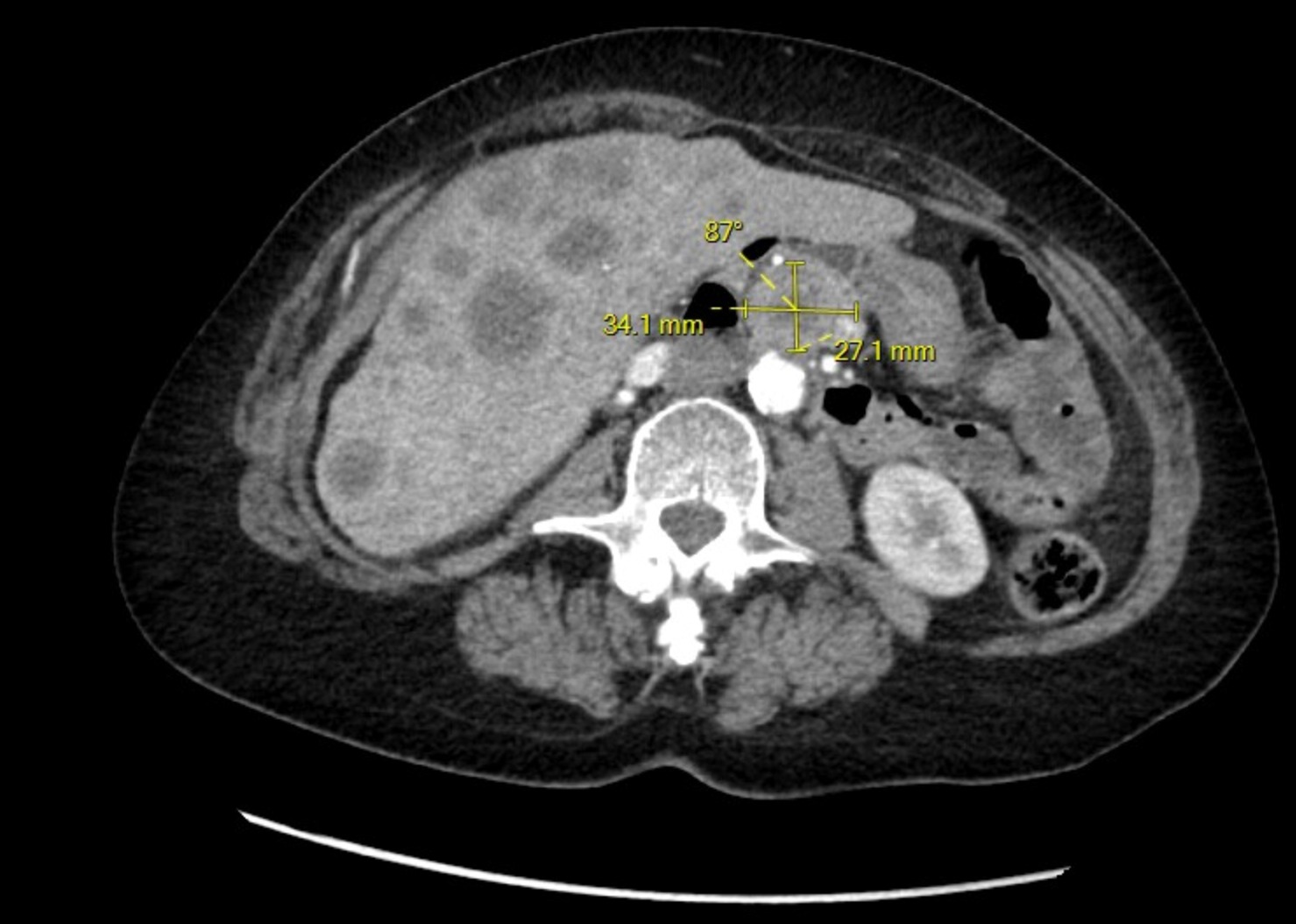Tuesday Poster Session
Category: Biliary/Pancreas
P2980 - Rare Case of Pancreatic Head Adenocarcinoma With Neuroendocrine Differentiation
Tuesday, October 24, 2023
10:30 AM - 4:00 PM PT
Location: Exhibit Hall

Has Audio

Varshita Goduguchinta, DO
Franciscan Health Olympia Fields
Chicago, IL
Presenting Author(s)
Varshita Goduguchinta, DO1, Rahil Desai, DO2, Mohammed Khan, DO3, Nicholas Baur, DO1, Faizan Khan, MD3, Ashirf Al-Ghanoudi, MD, MPH, FACG3
1Franciscan Health Olympia Fields, Chicago, IL; 2Franciscan Health Olympia Fields, Westlake, OH; 3Franciscan Health Olympia Fields, Olympia Fields, IL
Introduction: A majority of pancreatic cancers are adenocarcinomas, while less than 10% are neuroendocrine tumors. Combination of pancreatic adenocarcinomas with neuroendocrine differentiation (NED) has rarely been described in literature, but is crucial to differentiate, as treatment options vastly change. The confirmation of diagnosis of NED in patients with adenocarcinoma often occurs through immunohistological analysis. We present a case of a patient who presents with significant unintentional weight loss and concerning findings noted on CT imaging.
Case Description/Methods: A 72 year-old female with a medical history of hypertension presented with complaints of 6 weeks of extreme fatigue, decreased appetite, and 30-lb unintentional weight loss. CEA was elevated at 9.3. CT A/P revealed diffuse liver lesions suspicious for metastases and a mass along the superior margin of the pancreatic head with mild pancreatic ductal dilation. Patient underwent EGD with EUS for further evaluation. Cytological analysis by endoscopic ultrasonography-guided fine-needle aspiration (EUS-FNA) was performed on the pancreatic mass and it showed a hypoechoic and cystic appearance with invasion into the portal vein. EUS-FNA was also performed on the liver lesions located in the left lobe which were hypoechoic and suggestive of metastases. Ultimately, pathology of pancreatic head and liver lesions revealed poorly-differentiated pancreatic ductal adenocarcinoma with NED. The results of the immunohistological staining showed strong positivity for Synaptophysin (tumor marker protein for neuroendocrine cells). This indicated confirmation of NED in pancreatic adenocarcinoma of the patient. The patient is now currently deciding on aggressive treatment options including surgical resection, and is continuing to follow-up on a close basis with the GI team.
Discussion: Presentation of NED in pancreatic adenocarcinoma is a rare entity, often requiring advanced and aggressive treatment options. Although cancer survival rates are low, approximately 9%, it is important that treatment options are considered early in the diagnosis. In addition, large tumor size, high grade, and liver metastasis is often a cause for a less favorable prognosis. The major differences between pancreatic adenocarcinoma with NED are not fully understood, as cases are rare. Our patient presentation of NED in pancreatic adenocarcinoma presents a unique case, requiring further understanding of the role of this complex malignancy with a poor prognosis.

Disclosures:
Varshita Goduguchinta, DO1, Rahil Desai, DO2, Mohammed Khan, DO3, Nicholas Baur, DO1, Faizan Khan, MD3, Ashirf Al-Ghanoudi, MD, MPH, FACG3. P2980 - Rare Case of Pancreatic Head Adenocarcinoma With Neuroendocrine Differentiation, ACG 2023 Annual Scientific Meeting Abstracts. Vancouver, BC, Canada: American College of Gastroenterology.
1Franciscan Health Olympia Fields, Chicago, IL; 2Franciscan Health Olympia Fields, Westlake, OH; 3Franciscan Health Olympia Fields, Olympia Fields, IL
Introduction: A majority of pancreatic cancers are adenocarcinomas, while less than 10% are neuroendocrine tumors. Combination of pancreatic adenocarcinomas with neuroendocrine differentiation (NED) has rarely been described in literature, but is crucial to differentiate, as treatment options vastly change. The confirmation of diagnosis of NED in patients with adenocarcinoma often occurs through immunohistological analysis. We present a case of a patient who presents with significant unintentional weight loss and concerning findings noted on CT imaging.
Case Description/Methods: A 72 year-old female with a medical history of hypertension presented with complaints of 6 weeks of extreme fatigue, decreased appetite, and 30-lb unintentional weight loss. CEA was elevated at 9.3. CT A/P revealed diffuse liver lesions suspicious for metastases and a mass along the superior margin of the pancreatic head with mild pancreatic ductal dilation. Patient underwent EGD with EUS for further evaluation. Cytological analysis by endoscopic ultrasonography-guided fine-needle aspiration (EUS-FNA) was performed on the pancreatic mass and it showed a hypoechoic and cystic appearance with invasion into the portal vein. EUS-FNA was also performed on the liver lesions located in the left lobe which were hypoechoic and suggestive of metastases. Ultimately, pathology of pancreatic head and liver lesions revealed poorly-differentiated pancreatic ductal adenocarcinoma with NED. The results of the immunohistological staining showed strong positivity for Synaptophysin (tumor marker protein for neuroendocrine cells). This indicated confirmation of NED in pancreatic adenocarcinoma of the patient. The patient is now currently deciding on aggressive treatment options including surgical resection, and is continuing to follow-up on a close basis with the GI team.
Discussion: Presentation of NED in pancreatic adenocarcinoma is a rare entity, often requiring advanced and aggressive treatment options. Although cancer survival rates are low, approximately 9%, it is important that treatment options are considered early in the diagnosis. In addition, large tumor size, high grade, and liver metastasis is often a cause for a less favorable prognosis. The major differences between pancreatic adenocarcinoma with NED are not fully understood, as cases are rare. Our patient presentation of NED in pancreatic adenocarcinoma presents a unique case, requiring further understanding of the role of this complex malignancy with a poor prognosis.

Figure: CT Abdomen Pelvis highlighting a 3.4 cm x 2.7 cm pancreatic head adenocarcinoma with neuroendocrine differentiation
Disclosures:
Varshita Goduguchinta indicated no relevant financial relationships.
Rahil Desai indicated no relevant financial relationships.
Mohammed Khan indicated no relevant financial relationships.
Nicholas Baur indicated no relevant financial relationships.
Faizan Khan indicated no relevant financial relationships.
Ashirf Al-Ghanoudi indicated no relevant financial relationships.
Varshita Goduguchinta, DO1, Rahil Desai, DO2, Mohammed Khan, DO3, Nicholas Baur, DO1, Faizan Khan, MD3, Ashirf Al-Ghanoudi, MD, MPH, FACG3. P2980 - Rare Case of Pancreatic Head Adenocarcinoma With Neuroendocrine Differentiation, ACG 2023 Annual Scientific Meeting Abstracts. Vancouver, BC, Canada: American College of Gastroenterology.
